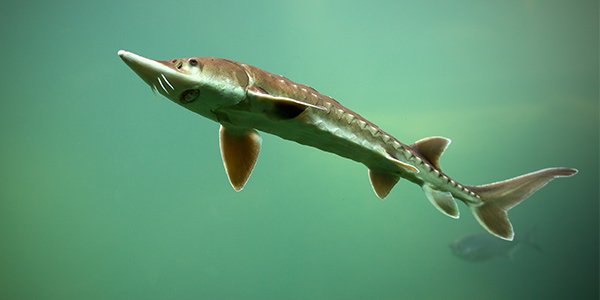
Unique in the animal world for their primitive appearance, sturgeons are fascinating creatures that have been around for millions of years. Their morphologies have remained largely the same throughout the fossil record, making them living fossils. Sturgeon is the common name for the 27 species of fish belonging to the family Acipenseridae. A list of common strugeon spieces we see down here.
• Genus Acipenser
1) Siberian Sturgeon (Acipenser Baerii)
Extremely valuable in the aquaculture industry, Siberian sturgeons are farmed for both meat and caviar. This species can grow to be massive, with record weights above 200 kg (440 pounds). Slow to reach reproductive maturity, they can live up to 60 years old. The slow rate of maturation has increased this species’ vulnerability to overfishing in the wild.
2 (Acipenser Brevirostrum)
The short nose sturgeon (Acipenser Brevirostrum) is a small and endangered species of North American sturgeon. The earliest remains of the species are from the Late Cretaceous Period, over 70 million years ago. Short nose sturgeons are long-lived and slow to sexually mature.
3) Acipenser Dabryanus
Dabry's sturgeon, Acipenser dabryanus, is a relatively small (130 cm, 16 kg) and now rare sturgeon restricted to the Yangtze River Basin.
4) Acipenser Fulvenscens
Acipenser Fulvescens are one of the few fishes to have taste buds on the outside of their mouth. In other fish, they are normally found on the tongue or inside the mouth. The taste buds of the lake sturgeon protrude from the toothless mouth and are used to help in the selection of food.
5) Acipenser Gueldenstaedtii
The Russian Sturgeon Acipenser Gueldenstaedtii may live to 48 years weighing around 100 kg. The species matures sexually between 8-16 years and most female spawners in the wild are aged 13-23 years. Spawning occurs every 2-3 years.
6) Acipenser Medirostris
Green sturgeon (Acipenser medirostris) occurs in coastal waters from Alaska to Mexico, and the Southern Distinct Population Segment (DPS), which spawns only in the Sacramento River basin, was listed as threatened under the US Endangered Species Act in 2006 by the National Marine Fisheries Service, due to reproductive isolation, limited spawning habitat and low estimated population abundance.
7) Acipenser Mikado
Acipenser Mikado (Sakhalin sturgeon) occurs in the Sea of Japan, from Korea to Northern Japan, in the Tatar Strait, in the Sakhalin Island waters.
8) Acipenser Naccarii
Acipenser Naccarii is usually included as one of these euryhaline species because it has been captured in the Adriatic Sea, although it breeds in freshwater.
9)Acipenser Nudiventris
Acipenser nudiventris or ship sturgeon are usually anadromous. Meaning they live in saltwater and travel to freshwaters to deposit eggs--but some can spend their entire life cycle in freshwater
10) Oxyrinchus Desotoi,
The gulf sturgeon is restricted to the Gulf of Mexico from Tampa Bay, Florida to Lake Ponchartrain, Louisiana. It is quite difficult to visually distinguish the gulf sturgeon from the Atlantic sturgeon (A. oxyrinchus).
11) Oxyrinchus Oxyrinchus,
Atlantic sturgeon Acipenser oxyrinchus oxyrinchus
The Atlantic sturgeon is one of two subspecies of A. oxyrinchus, the other being the Gulf sturgeon (A. o. desotoi). The main range of the Atlantic sturgeon is in eastern North America.
12)Acipenser Persicus
Persian sturgeon (Acipenser persicus) found in the Caspian Sea and to a lesser extent the Black Sea and ascends certain rivers to spawn, mainly the Volga, Kura, Araks and Ural Rivers.
13) Acipenser Ruthenus
Acipenser Ruthenus. Preferred Common Name sterlet. This sturgeon inhabits rivers that flow into the following seas: Caspian, Black, Azov, Baltic, White, Barents, Kara, and inhabits both the Black and Caspian seas. The sterlet has the shortest life span (22-24 years old) in the genus Acipenser and females live longer than males.
14) Acipenser Schrenckii
The Japanese sturgeon, or Amur sturgeon (Acipenser schrenckii) is a species of fish in the family Acipenseridae found in the Amur River basin in China and Russia.
15) Acipenser Sinensis
Acipenser sinensis Preferred Common Name; Chinese sturgeon. The Chinese sturgeon, Acipenser sinensis, is a large member of Acipenseridae now found only in the Yangtze River and the Yellow and East China seas.
16) Acipenser Stellatus
The Stellate Sturgeon (Acipenser Stellatus) is very easy to recognize as the nose and head is up to a 1/4 of the total length of the fish. The snout is very long flatted and bent upwards towards the tip, it exceeds 60% of the head's length and looks almost alligator like. The barbels are smooth (not fimbrillate) and are positioned closer to the mouth than to the top of the snout. The body is spindle shaped almost eel or snake like it has much less body mass in relation to length than most other sturgeons.
17) Aciperser Sturio
The European sturgeon Acipenser sturio is one of the largest species of fish to occur in freshwater but also one of the most endangered. It is an anadromous (migratory) fish, spending most of its adult life in marine waters but migrating into freshwater to reproduce and spawn.
18) Acipenser Transmontanus
White Sturgeon (Acipenser Transmontanus) is an anadromous fish species native to the eastern Pacific. It is used in commercial fisheries, game fishing, and aquaculture. This species is landlocked in the Columbia River drainage, Montana, and perhaps Lake Shasta in California.
Genus Huso
1) Huso Clauricus
The Kaluga (Huso Dauricus) is a large predatory sturgeon found in the Amur River basin.
2) Huso Huso
The world's largest freshwater fish is the Beluga Sturgeon. The beluga sturgeon, Huso Huso, is endemic to the Ponto-Caspian Sea region that includes the Caspian Sea (the largest inland body of water in the world) as well as the Sea of Azov and the Black Sea.
Genus Polyodon
1) Polyodon Spathula
The American paddlefish (Polyodon spathula) is a species of basal ray-finned fish closely related to sturgeons in the order Acipenseriformes. Fossil records of paddlefish date back over 125 million years to the Early Cretaceous.
2) Psephurus Gladius
The Chinese paddlefish, Psephurus gladius, was one of only two extant members of a relict lineage that was most diverse and widespread 34–75 million years ago. It is also one of the largest freshwater fish species, reaching up to 7 m in length.
Genus Pseudoscaphirthynchus
1) Pseudoscaphirthynchus fedtschenkoi
Pseudoscaphirhynchus fedtschenkoi spends its whole life in freshwater. Unfortunately, little is known about the biology and ecology of the species. The Syr Darya is characterised as a turbid river with a mean annual sediment out wash from the Naryn and Kara Darya drainage (which meet to form the Syr Darya) of 357 t/km2 (Salikhov and Kamilov, 1995). The native fish fauna of the Syr Darya including P. fedtschenkoi is especially adapted to turbid waters.
2) Pseudoscaphirthynchus hermanni
The Dwarf Sturgeon (Pseudoscaphirhynchus hermanni) has 9-13 dorsal scutes, 31-39 lateral scutes, 6-9 ventral scutes, 27-35 dorsal fin rays and 15-21 anal fin rays. The snout is long, flat and shovel-like. The four barbels are located closer to the mouth than the end of the snout.
3) Pseudoscaphirthynchus Kaufmanni
The Amu Darya Sturgeon (Pseudoscaphirhynchus kaufmanni) has 10-14 dorsal scutes, 30-38 lateral scutes, 6-10 ventral scutes, 25-37 dorsal fin rays and 15-24 anal fin rays. The snout is long and shovel-like. The four barbels are located closer to the mouth than the end of the snout; the outer ones are longer than the inner ones. There are 2-4 spines on the rostrum and pairs of spines between and behind the eyes. The caudal fin tapers into a long filament. The back is grey to black and the ventral side is white.
Genus Scaphirthynchus
1) Scaphirthynchus Albus
(Scaphirhynchus Albus) Pallid sturgeon are bottom dwelling, slow growing fish that feed primarily on small fish and immature aquatic insects. This species of sturgeon is seldom seen and is one of the least understood fish in the Missouri and Mississippi River drainages. It is an ancient species that has existed since the days of the dinosaurs.
2) Scaphirthynchus Platorynchus
Shovelnose Sturgeon (Scaphirhynchus platorynchus) Fish of the Mississippi River. Introduction. The shovelnose sturgeon is a fish of river currents, depending on sandy or gravel beds as a safe place to lay eggs. Small crevices and hollows protect eggs and newly hatched fish.
3) Scaphirthynchus Suttkusi
The Alabama sturgeon (Scaphirhyncus Suttkusi) was listed as an endangered species on May 5, 2000 (65 FR 26438). Its historic range encompassed all major rivers in the Mobile Basin, below the Fall Line, including the Alabama, Tombigbee, and Cahaba River systems.

